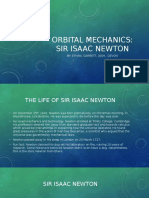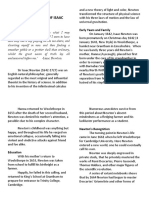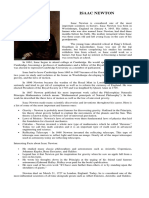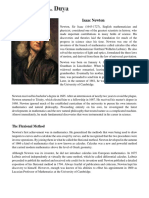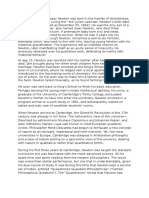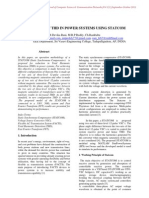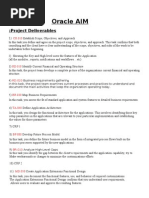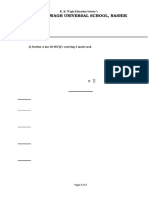Biography Sir Isaac Newton Ingles
Biography Sir Isaac Newton Ingles
Uploaded by
MariCruzCoriChacoCopyright:
Available Formats
Biography Sir Isaac Newton Ingles
Biography Sir Isaac Newton Ingles
Uploaded by
MariCruzCoriChacoOriginal Title
Copyright
Available Formats
Share this document
Did you find this document useful?
Is this content inappropriate?
Copyright:
Available Formats
Biography Sir Isaac Newton Ingles
Biography Sir Isaac Newton Ingles
Uploaded by
MariCruzCoriChacoCopyright:
Available Formats
Biography Sir Isaac Newton
Sir Issac Newton (1643- 1726) was an English Mathematical achievements of Newton
mathematician, physicist and scientist. He is widely
regarded as one of the most influential scientists of
all time, developing new laws of mechanics, gravity Generalized binomial theorem
and laws of motion. His work Principia
Mathematica (1687) laid the framework for the Newton’s identities,
Scientific Revolution of the Seventeenth Century. A
Newton’s method,
great polymath, Newton’s investigations also
included areas of optics, religion and alchemy. Classified cubic plane curves (polynomials
of degree three in two variables),
Early Life of Newton
Substantial contributions to the theory of
Sir Isaac Newton was born on Christmas Day, in finite differences,
1643, to a relatively poor farming family. His father
Use of fractional indices
died three months before he was born. His mother
later remarried, but her second husband did not get Used geometry to derive solutions to
on with Isaac; leading to friction between Isaac and Diophantine equations.
his parents. The young Isaac attended school at
King’s School, Grantham in Lincolnshire (where his Used power series with confidence and to
signature is still inscribed on the walls.) Isaac was revert power series.
one of the top students, but before completing his
studies his mother withdrew him from school, so Discovered a new formula for pi.
Isaac could work as a farmer. It was only through
the intervention of the headmaster that Isaac was
Scientific Achievements of Newton
able to return to finish his studies; he passed his
final exams with very good results and was able to
go to Trinity College, Cambridge. Optics – Newton made great
advancements in the study of optics. In
Newton at Cambridge particular, he developed the spectrum by
splitting white light through a prism.
At Cambridge, he was able to pursue his interests Telescope – Made significant
in mathematics, science and physics. At the time improvements to the development of the
the prevailing education was based on Aristotle, but telescope. However, when his ideas were
Isaac was more interested in modern criticised by Hooke, Newton withdrew from
mathematicians such as Rene Descartes. Isaac the public debate. He developed an
Newton had a prodigious capacity to consider antagonistic and hostile attitude to Hooke,
mathematical problems, and then focus on them throughout his life.
until he had solved the mystery behind them. His
one-pointed nature led him to, at times, be detached Mechanics and Gravitation. In his famous
from the world. For example, he had little time for book Principia Mathematica. (1687) Newton
women. An early teenage romance came to explained the three laws of motion that laid
nothing, and he remained single throughout his life. the framework for modern physics.
This involved explaining planetary
Sir Isaac Newton, has been referred to as one of movements.
the greatest geniuses of history. His mathematical
and scientific achievements give credence to such Newton hit on the head with an Apple
a view. His many accomplishments in the field of
science include:
The most popular anecdote about Sir Isaac Newton
is the story of how the theory of gravitation came to
Developing a theory of calculus. Unfortunately, at
him, after being hit on the head with a falling apple.
the same time as Newton, calculus was being
In reality, Newton and his friends may have
developed by Leibniz. When Leibniz published his
exaggerated this story. Nevertheless, it is quite
results, there was a bitter feud between the two
likely that seeing apples fall from trees may have
men, with Newton claiming plagiarism. This bitter
influenced his theories of gravity.
feud lasted until Leibniz death in 1713, it also
extended between British mathematicians and the
continent.
Biografía Sir Isaac Newton también se extendió entre los matemáticos
británicos y el continente.
Sir Issac Newton (1643-1726) fue un matemático,
físico y científico inglés. Es considerado como uno Logros matemáticos de newton.
de los científicos más influyentes de todos los
tiempos, desarrollando nuevas leyes de la • Teorema del binomio generalizado.
mecánica, la gravedad y las leyes del movimiento.
Su obra Principia Mathematica (1687) estableció el • Las identidades de Newton,
marco para la Revolución científica del siglo XVII.
Las investigaciones de Newton, que fueron un gran • El método de Newton.
alboroto, también incluyeron áreas de la óptica, la
religión y la alquimia. • Curvas de plano cúbico clasificadas (polinomios
de grado tres en dos variables),
Vida temprana de Newton
• Contribuciones sustanciales a la teoría de las
Sir Isaac Newton nació el día de Navidad, en 1643, diferencias finitas,
en una familia de agricultores relativamente pobres.
Su padre murió tres meses antes de que él naciera. • Uso de índices fraccionales.
Su madre se volvió a casar más tarde, pero su
segundo marido no se llevó bien con Isaac; • Geometría utilizada para derivar soluciones a
llevando a la fricción entre Isaac y sus padres. El ecuaciones diofánticas.
joven Isaac asistió a la escuela en King's School,
Grantham en Lincolnshire (donde su firma todavía
• Utiliza series de potencia con confianza y para
está inscrita en las paredes). Isaac era uno de los
revertir series de potencia.
mejores estudiantes, pero antes de completar sus
estudios, su madre lo retiró de la escuela, por lo que
Isaac podría trabajar como un granjero. Solo a • Descubrí una nueva fórmula para pi.
través de la intervención del director, Isaac pudo
regresar para terminar sus estudios; Pasó sus Logros científicos de Newton
exámenes finales con muy buenos resultados y
pudo ir a Trinity College, Cambridge. • Óptica - Newton hizo grandes avances en el
estudio de la óptica. En particular, desarrolló el
Newton en Cambridge espectro dividiendo la luz blanca a través de un
prisma.
En Cambridge, fue capaz de perseguir sus
intereses en matemáticas, ciencias y física. En ese • Telescopio: realizó mejoras significativas en el
momento, la educación predominante se basaba desarrollo del telescopio. Sin embargo, cuando sus
en Aristóteles, pero Isaac estaba más interesado en ideas fueron criticadas por Hooke, Newton se retiró
los matemáticos modernos como Rene Descartes. del debate público. Desarrolló una actitud
Isaac Newton tenía una capacidad prodigiosa para antagónica y hostil hacia Hooke, a lo largo de su
considerar problemas matemáticos, y luego vida.
enfocarse en ellos hasta que hubiera resuelto el
misterio detrás de ellos. Su naturaleza • Mecánica y gravitación. En su famoso libro
unidireccional lo llevó, a veces, a separarse del Principia Mathematica. (1687) Newton explicó las
mundo. Por ejemplo, tenía poco tiempo para las tres leyes del movimiento que sentaron las bases
mujeres. Un romance adolescente temprano se de la física moderna.
quedó en nada, y permaneció soltero durante toda
su vida. Esto implicaba explicar los movimientos
planetarios.
Sir Isaac Newton, ha sido considerado como uno
de los más grandes genios de la historia. Sus logros Newton golpeó en la cabeza con una manzana
matemáticos y científicos dan crédito a tal visión.
Sus muchos logros en el campo de la ciencia La anécdota más popular sobre Sir Isaac Newton
incluyen: es la historia de cómo le llegó la teoría de la
gravitación, después de haber sido golpeada en la
Desarrollando una teoría del cálculo. cabeza con una manzana que caía. En realidad,
Desafortunadamente, al mismo tiempo que Newton y sus amigos pueden haber exagerado
Newton, el cálculo estaba siendo desarrollado por esta historia. Sin embargo, es muy probable que al
Leibniz. Cuando Leibniz publicó sus resultados, ver caer las manzanas de los árboles haya influido
hubo una amarga pelea entre los dos hombres, con sus teorías de la gravedad.
Newton reclamando plagio. Esta amarga
enemistad duró hasta la muerte de Leibniz en 1713,
English physicist and mathematician Sir Isaac
Newton, most famous for his law of gravitation, was
instrumental in the scientific revolution of the 17th
century.
Who Was Isaac Newton?
Isaac Newton (January 4, 1643 to March 31, 1727) the apple actually hit Newton on the head, he did
was a physicist and mathematician who developed see an apple fall from a tree, leading him to wonder
the principles of modern physics, including the laws why it fell straight down and not at an angle.
of motion, and is credited as one of the great minds Consequently, he began exploring the theories of
of the 17th century Scientific Revolution. In 1687, motion and gravity.
he published his most acclaimed work,
Philosophiae Naturalis Principia Mathematica It was during this 18-month hiatus as a student that
(Mathematical Principles of Natural Philosophy), Newton conceived many of his most important
which has been called the single most influential insights—including the method of infinitesimal
book on physics. In 1705, he was knighted by calculus, the foundations for his theory of light and
Queen Anne of England, making him Sir Isaac color, and the laws of planetary motion—that
Newton. eventually led to the publication of his physics book
Principia and his theory of gravity.
When Was Isaac Newton Born?
'Principia' and Newton’s Laws of Motion
Isaac Newton was born on January 4, 1643, in
Woolsthorpe, Lincolnshire, England. Using the "old" In 1687, following 18 months of intense and
Julien calendar, Newton's birth date is sometimes effectively nonstop work, Newton published
displayed as December 25, 1642. Philosophiae Naturalis Principia Mathematica
(Mathematical Principles of Natural Philosophy),
Isaac Newton’s Discoveries most often known as Principia. It is said to be the
single most influential book on physics and possibly
Newton made discoveries in optics, motion and all of science. Its publication immediately raised
mathematics. Newton theorized that white light was Newton to international prominence.
a composite of all colors of the spectrum, and that
light was composed of particles. His momentous Principia offers an exact quantitative description of
book on physics, Principia, contains information on bodies in motion, with three basic laws of motion:
nearly all of the essential concepts of physics
except energy, ultimately helping him to explain the 1) A stationary body will stay stationary unless an
laws of motion and the theory of gravity. Along with external force is applied to it.
mathematician Gottfried Wilhelm von Leibniz,
Newton is credited for developing essential theories 2) Force is equal to mass times acceleration, and a
of calculus. change in motion (i.e., change in speed) is
proportional to the force applied.
What Did Isaac Newton Invent?
3) For every action, there is an equal and opposite
Newton's first major public scientific achievement reaction.
was designing and constructing a reflecting
telescope in 1668. As a professor at Cambridge, Newton and the Theory of Gravity
Newton was required to deliver an annual course of
lectures and chose optics as his initial topic. He Newton’s three basic laws of motion outlined in
used his telescope to study optics and help prove Principia helped him arrive at his theory of gravity.
his theory of light and color. The Royal Society Newton’s law of universal gravitation states that two
asked for a demonstration of his reflecting objects attract each other with a force of
telescope in 1671, and the organization's interest gravitational attraction that’s proportional to their
encouraged Newton to publish his notes on light, masses and inversely proportional to the square of
optics and color in 1672. These notes were later the distance between their centers.
published as part of Newton's Opticks: Or, A
treatise of the Reflections, Refractions, Inflections These laws helped explain not only elliptical
and Colours of Light. planetary orbits but nearly every other motion in the
universe: how the planets are kept in orbit by the
The Apple Myth pull of the sun’s gravity; how the moon revolves
around Earth and the moons of Jupiter revolve
Between 1665 and 1667, Newton returned home around it; and how comets revolve in elliptical orbits
from Trinity College to pursue his private study, as around the sun. They also allowed him to calculate
school was closed due to the Great Plague. Legend the mass of each planet, calculate the flattening of
has it that, at this time, Newton experienced his the Earth at the poles and the bulge at the equator,
famous inspiration of gravity with the falling apple. and how the gravitational pull of the sun and moon
According to this common myth, Newton was sitting create the Earth’s tides. In Newton's account,
under an apple tree when a fruit fell and hit him on gravity kept the universe balanced, made it work,
the head, inspiring him to suddenly come up with
the theory of gravity. While there is no evidence that
and brought heaven and Earth together in one great performance, but one that is understandable, given
equation. his dual course of study. It was during this time that
Newton kept a second set of notes, entitled
Early Life and Family "Quaestiones Quaedam Philosophicae" ("Certain
Philosophical Questions"). The "Quaestiones"
Isaac Newton was the only son of a prosperous reveal that Newton had discovered the new concept
local farmer, also named Isaac Newton, who died of nature that provided the framework for the
three months before he was born. A premature Scientific Revolution. Though Newton graduated
baby born tiny and weak, Newton was not expected without honors or distinctions, his efforts won him
to survive. When he was 3 years old, his mother, the title of scholar and four years of financial support
Hannah Ayscough Newton, remarried a well-to-do for future education.
minister, Barnabas Smith, and went to live with him,
leaving young Newton with his maternal In 1665, the Great Plague that was ravaging Europe
grandmother. The experience left an indelible had come to Cambridge, forcing the university to
imprint on Newton, later manifesting itself as an close. After a two-year hiatus, Newton returned to
acute sense of insecurity. He anxiously obsessed Cambridge in 1667 and was elected a minor fellow
over his published work, defending its merits with at Trinity College, as he was still not considered a
irrational behavior. standout scholar. In the ensuing years, his fortune
improved. Newton received his Master of Arts
At age 12, Newton was reunited with his mother degree in 1669, before he was 27. During this time,
after her second husband died. She brought along he came across Nicholas Mercator's published
her three small children from her second marriage. book on methods for dealing with infinite series.
Newton quickly wrote a treatise, De Analysi,
Education expounding his own wider-ranging results. He
shared this with friend and mentor Isaac Barrow, but
Newton was enrolled at the King's School in didn't include his name as author.
Grantham, a town in Lincolnshire, where he lodged
with a local apothecary and was introduced to the In June 1669, Barrow shared the unaccredited
fascinating world of chemistry. His mother pulled manuscript with British mathematician John Collins.
him out of school at age 12. Her plan was to make In August 1669, Barrow identified its author to
him a farmer and have him tend the farm. Newton Collins as "Mr. Newton ... very young ... but of an
failed miserably, as he found farming monotonous. extraordinary genius and proficiency in these
Newton was soon sent back to King's School to things." Newton's work was brought to the attention
finish his basic education. of the mathematics community for the first time.
Shortly afterward, Barrow resigned his Lucasian
Perhaps sensing the young man's innate professorship at Cambridge, and Newton assumed
intellectual abilities, his uncle, a graduate of the the chair.
University of Cambridge's Trinity College,
persuaded Newton's mother to have him enter the Isaac Newton & Robert Hooke
university. Newton enrolled in a program similar to
a work-study in 1661, and subsequently waited on Not everyone at the Royal Academy was
tables and took care of wealthier students' rooms. enthusiastic about Newton’s discoveries in optics
and 1672 publication of Opticks: Or, A treatise of the
When Newton arrived at Cambridge, the Scientific Reflections, Refractions, Inflections and Colours of
Revolution of the 17th century was already in full Light. Among the dissenters was Robert Hooke,
force. The heliocentric view of the universe— one of the original members of the Royal Academy
theorized by astronomers Nicolaus Copernicus and and a scientist who was accomplished in a number
Johannes Kepler, and later refined by Galileo—was of areas, including mechanics and optics. While
well known in most European academic circles. Newton theorized that light was composed of
Philosopher René Descartes had begun to particles, Hooke believed it was composed of
formulate a new concept of nature as an intricate, waves. Hooke quickly condemned Newton's paper
impersonal and inert machine. Yet, like most in condescending terms, and attacked Newton's
universities in Europe, Cambridge was steeped in methodology and conclusions.
Aristotelian philosophy and a view of nature resting
on a geocentric view of the universe, dealing with
nature in qualitative rather than quantitative terms.
Hooke was not the only one to question Newton's
During his first three years at Cambridge, Newton work in optics. Renowned Dutch scientist Christiaan
was taught the standard curriculum but was Huygens and a number of French Jesuits also
fascinated with the more advanced science. All his raised objections. But because of Hooke's
spare time was spent reading from the modern association with the Royal Society and his own work
philosophers. The result was a less-than-stellar in optics, his criticism stung Newton the worst.
Unable to handle the critique, he went into a rage— the inverse square of the distance between them
a reaction to criticism that was to continue (Hooke's theory).
throughout his life. Newton denied Hooke's charge
that his theories had any shortcomings and argued Newton knew the answer, due to his concentrated
the importance of his discoveries to all of science. work for the past six years, and replied, "An ellipse."
In the ensuing months, the exchange between the Newton claimed to have solved the problem some
two men grew more acrimonious, and soon Newton 18 years prior, during his hiatus from Cambridge
threatened to quit the society altogether. He and the plague, but he was unable to find his notes.
remained only when several other members Halley persuaded him to work out the problem
assured him that the Fellows held him in high mathematically and offered to pay all costs so that
esteem. the ideas might be published, which it was, in
Newton’s Principia.
Sir Isaac Newton
Upon the publication of the first edition of Principia
Isaac of all trades. English scientist and in 1687, Robert Hooke immediately accused
mathematician Isaac Newton is most famous for his Newton of plagiarism, claiming that he had
law of gravitation, and was instrumental in the discovered the theory of inverse squares and that
scientific revolution of the 17th century. Above: A Newton had stolen his work. The charge was
photo of Newton Investigating Light, a portrayal of unfounded, as most scientists knew, for Hooke had
Isaac Newton created by J A Houston, circa 1879. only theorized on the idea and had never brought it
to any level of proof.
The rivalry between Newton and Hooke would
continue for several years thereafter. Then, in 1678, Newton, however, was furious and strongly
Newton suffered a complete nervous breakdown defended his discoveries. He withdrew all
and the correspondence abruptly ended. The death references to Hooke in his notes and threatened to
of his mother the following year caused him to withdraw from publishing the subsequent edition of
become even more isolated, and for six years he Principia altogether. Halley, who had invested much
withdrew from intellectual exchange except when of himself in Newton's work, tried to make peace
others initiated correspondence, which he always between the two men. While Newton begrudgingly
kept short. agreed to insert a joint acknowledgement of
Hooke's work (shared with Wren and Halley) in his
During his hiatus from public life, Newton returned discussion of the law of inverse squares, it did
to his study of gravitation and its effects on the nothing to placate Hooke.
orbits of planets. Ironically, the impetus that put
Newton on the right direction in this study came As the years went on, Hooke's life began to unravel.
from Robert Hooke. In a 1679 letter of general His beloved niece and companion died the same
correspondence to Royal Society members for year that Principia was published, in 1687. As
contributions, Hooke wrote to Newton and brought Newton's reputation and fame grew, Hooke's
up the question of planetary motion, suggesting that declined, causing him to become even more bitter
a formula involving the inverse squares might and loathsome toward his rival. To the bitter end,
explain the attraction between planets and the Hooke took every opportunity he could to offend
shape of their orbits. Newton. Knowing that his rival would soon be
elected president of the Royal Society, Hooke
Subsequent exchanges transpired before Newton refused to retire until the year of his death, in 1703.
quickly broke off the correspondence once again.
But Hooke's idea was soon incorporated into Final Years
Newton's work on planetary motion, and from his
notes it appears he had quickly drawn his own Toward the end of this life, Newton lived at
conclusions by 1680, though he kept his Cranbury Park, near Winchester, England, with his
discoveries to himself. niece, Catherine (Barton) Conduitt, and her
husband, John Conduitt. By this time, Newton had
In early 1684, in a conversation with fellow Royal become one of the most famous men in Europe. His
Society members Christopher Wren and Edmond scientific discoveries were unchallenged. He also
Halley, Hooke made his case on the proof for had become wealthy, investing his sizable income
planetary motion. Both Wren and Halley thought he wisely and bestowing sizable gifts to charity.
was on to something, but pointed out that a
mathematical demonstration was needed. In Despite his fame, Newton's life was far from perfect:
August 1684, Halley traveled to Cambridge to visit He never married or made many friends, and in his
with Newton, who was coming out of his seclusion. later years, a combination of pride, insecurity and
Halley idly asked him what shape the orbit of a side trips on peculiar scientific inquiries led even
planet would take if its attraction to the sun followed some of his few friends to worry about his mental
stability.
Newton’s Death
By the time he reached 80 years of age, Newton
was experiencing digestion problems and had to
drastically change his diet and mobility. In March
1727, Newton experienced severe pain in his
abdomen and blacked out, never to regain
consciousness. He died the next day, on March 31,
1727, at the age of 84.
Legacy
Isaac Newton's fame grew even more after his
death, as many of his contemporaries proclaimed
him the greatest genius who ever lived. Maybe a
slight exaggeration, but his discoveries had a large
impact on Western thought, leading to comparisons
to the likes of Plato, Aristotle and Galileo.
Although his discoveries were among many made
during the Scientific Revolution, Isaac Newton's
universal principles of gravity found no parallels in
science at the time. Of course, Newton was proven
wrong on some of his key assumptions. In the 20th
century, Albert Einstein would overturn Newton's
concept of the universe, stating that space, distance
and motion were not absolute but relative, and that
the universe was more fantastic than Newton had
ever conceived.
Newton might not have been surprised: In his later
life, when asked for an assessment of his
achievements, he replied, "I do not know what I may
appear to the world; but to myself I seem to have
been only like a boy playing on the seashore, and
diverting myself now and then in finding a smoother
pebble or prettier shell than ordinary, while the great
ocean of truth lay all undiscovered before me."
You might also like
- Philips MX800 PDFDocument11 pagesPhilips MX800 PDFSERGIO PEREZNo ratings yet
- Isaac NewtonDocument10 pagesIsaac NewtonJustine Lisette PedrajasNo ratings yet
- Orbital Motion 2Document7 pagesOrbital Motion 2api-247530883No ratings yet
- Issac Newton Rough Draft v1Document3 pagesIssac Newton Rough Draft v1api-253599101No ratings yet
- SPE 25157 Remediation of The Contaminated Ocean Floor Around Platforms in The Gulf of Mexico OffshoreDocument7 pagesSPE 25157 Remediation of The Contaminated Ocean Floor Around Platforms in The Gulf of Mexico OffshoreWaleed Barakat MariaNo ratings yet
- General Depreciation RatesDocument60 pagesGeneral Depreciation Rateshongquang1865573No ratings yet
- A Series of Unfortunate Events A Bad BeginningDocument3 pagesA Series of Unfortunate Events A Bad BeginningMica Ella Madria BulananNo ratings yet
- Early Life of NewtonDocument3 pagesEarly Life of Newtonich114No ratings yet
- Isaac Newton History ALLDocument3 pagesIsaac Newton History ALLvascoinovasaoNo ratings yet
- Biography Sir Isaac NewtonDocument3 pagesBiography Sir Isaac NewtonSatbir SinghNo ratings yet
- Isaac NewtonDocument2 pagesIsaac NewtonTeohYisianNo ratings yet
- Xviii The Roots of CalculusDocument3 pagesXviii The Roots of CalculusDaniel VargasNo ratings yet
- Presentation For MathDocument9 pagesPresentation For Mathapi-273439822No ratings yet
- WEEK 4 - History of Isaac NewtonDocument2 pagesWEEK 4 - History of Isaac NewtonElok SorayaNo ratings yet
- N412-Module 8.1 Assessment - CabalseDocument2 pagesN412-Module 8.1 Assessment - CabalseKeen Gementiza CabalseNo ratings yet
- Calculus: Isaac NewtonDocument12 pagesCalculus: Isaac NewtonSUETA DAVESNo ratings yet
- Isaac Newton - Quotes Collection: Biography, Achievements And Life LessonsFrom EverandIsaac Newton - Quotes Collection: Biography, Achievements And Life LessonsNo ratings yet
- Isaac NewtonDocument25 pagesIsaac NewtonMillicenth Vasquez De La CruzNo ratings yet
- Isaac NewonDocument5 pagesIsaac Newonnalel05No ratings yet
- Isaac Newton: BibliografiaDocument8 pagesIsaac Newton: BibliografiaAbraham ValenciaNo ratings yet
- Sir Issac NewtonDocument3 pagesSir Issac NewtonDan CristianNo ratings yet
- Biography of Isaac NewtonDocument7 pagesBiography of Isaac NewtonReyna Avila Ramírez-Arellano100% (1)
- Isaac NewtonDocument15 pagesIsaac Newtonapi-3855358No ratings yet
- DC Background Info Sir Isaac NewtonDocument1 pageDC Background Info Sir Isaac Newtonapi-272358521No ratings yet
- Principia: "The Mathematical Principles of Natural Philosophy"From EverandPrincipia: "The Mathematical Principles of Natural Philosophy"No ratings yet
- Sir Isaac Newton: Philosophiæ Naturalis Principia MathematicaDocument9 pagesSir Isaac Newton: Philosophiæ Naturalis Principia Mathematicaohm parmarNo ratings yet
- Isaac NewtonDocument1 pageIsaac NewtonlenaNo ratings yet
- Sir Isaac NewtonDocument22 pagesSir Isaac NewtonUpendra Reddy100% (1)
- The Principia. Mathematical Principles of Natural Philosophy (Concise Edition)From EverandThe Principia. Mathematical Principles of Natural Philosophy (Concise Edition)No ratings yet
- Isaack NewtonDocument10 pagesIsaack NewtonPrashant ShindeNo ratings yet
- Saac Newton: Early Life and EducationDocument9 pagesSaac Newton: Early Life and EducationGabriel André AlvesNo ratings yet
- Isaac NewtonDocument13 pagesIsaac NewtonRuban BillaNo ratings yet
- Isaac Newton: The Fluxional MethodDocument3 pagesIsaac Newton: The Fluxional MethodJajaNo ratings yet
- Philosophiæ Naturalis Principia Mathematica: Sir Isaac NewtonDocument9 pagesPhilosophiæ Naturalis Principia Mathematica: Sir Isaac NewtonManish ShethNo ratings yet
- Philosophiæ Naturalis Principia Mathematica: Isaac NewtonDocument6 pagesPhilosophiæ Naturalis Principia Mathematica: Isaac NewtonPedro Soto CruzNo ratings yet
- Sir Isaac Newton, PRS, (4 January 1643 - 31 March 1727)Document6 pagesSir Isaac Newton, PRS, (4 January 1643 - 31 March 1727)bookpalNo ratings yet
- Saac NewtonDocument4 pagesSaac NewtonMohit GaharanaNo ratings yet
- Sir Isaac NewtonDocument2 pagesSir Isaac NewtonMary Grace Herbania-Dahan LundayNo ratings yet
- Isaac NewtonDocument36 pagesIsaac NewtonAbdullah MuhammadNo ratings yet
- Biography of Isaac NewtonDocument4 pagesBiography of Isaac NewtonMary Gene Pascual FernandezNo ratings yet
- Isaac Newton Bio DR Robert HatchDocument10 pagesIsaac Newton Bio DR Robert Hatchpratapjhankar65No ratings yet
- Kliping Fisika Sir Isaac Newton: Nama: Rizal Junianto Kelas: Xi TKR 2 No Absen: 29Document5 pagesKliping Fisika Sir Isaac Newton: Nama: Rizal Junianto Kelas: Xi TKR 2 No Absen: 29bob826No ratings yet
- Sir Isaac Newton: Group 2: MembersDocument11 pagesSir Isaac Newton: Group 2: MembersRupert John LeeNo ratings yet
- Last Save Script U2Document5 pagesLast Save Script U2Phạm Việt ThắngNo ratings yet
- Isaac Newton Figurehead of EnlightenmentDocument20 pagesIsaac Newton Figurehead of EnlightenmentZdravko JovanovicNo ratings yet
- Sir Isaac Newton: Early LifeDocument3 pagesSir Isaac Newton: Early Liferose maryNo ratings yet
- STS Activity Sheet (Week 3) - Group 5Document3 pagesSTS Activity Sheet (Week 3) - Group 5Raine Avie S. TapiaNo ratings yet
- Episode 303 - Do You Know - Sir Isaac NewtonDocument13 pagesEpisode 303 - Do You Know - Sir Isaac NewtonEnglish Plus PodcastNo ratings yet
- Reading PractiseDocument5 pagesReading Practisepikachucute2107No ratings yet
- Sir Isaac Newton: Philosophiæ Naturalis Principia MathematicaDocument1 pageSir Isaac Newton: Philosophiæ Naturalis Principia MathematicaFerrariNo ratings yet
- Physics NewtonDocument7 pagesPhysics NewtonAhillan MNo ratings yet
- Physics ProjectDocument9 pagesPhysics Project78bynzhbpvNo ratings yet
- Isaac NewtonDocument2 pagesIsaac NewtonbhaskarmscNo ratings yet
- Isaac Newton: Mr. Shepp Hour 8Document7 pagesIsaac Newton: Mr. Shepp Hour 8Rudy RiceNo ratings yet
- Isaac Newton BiographyDocument5 pagesIsaac Newton BiographyMuhammadNo ratings yet
- Sir Isaac NewtonDocument13 pagesSir Isaac Newtonanu rettiNo ratings yet
- Isaac NewtonDocument3 pagesIsaac NewtonCourtney LeipertzNo ratings yet
- Issac Newton With PICDocument1 pageIssac Newton With PICusunomNo ratings yet
- About 5 PhycistsDocument6 pagesAbout 5 PhyciststharikaNo ratings yet
- Isaac Newton: Luis Diego Valle Mrs. Claudia Science 30/09/2014Document7 pagesIsaac Newton: Luis Diego Valle Mrs. Claudia Science 30/09/2014estherNo ratings yet
- ROPdefender A Detection Tool To Defend Against RetDocument13 pagesROPdefender A Detection Tool To Defend Against RetAlex CiacîruNo ratings yet
- LTE Power CalculatorDocument735 pagesLTE Power CalculatoratitNo ratings yet
- Tableau Desktop Specialist Study GuideDocument3 pagesTableau Desktop Specialist Study GuideMinh LeNo ratings yet
- GR 3 Math Chapter 11Document17 pagesGR 3 Math Chapter 11Kheyiru RediNo ratings yet
- Astm D 445 - 03Document10 pagesAstm D 445 - 03Jako MishyNo ratings yet
- Design and Development of Autonomated Chicken Slicing MachineDocument51 pagesDesign and Development of Autonomated Chicken Slicing MachineSheena Bejasa100% (1)
- Dgca Module 07 Part 05Document14 pagesDgca Module 07 Part 05Gaurav SinghNo ratings yet
- General MPDocument9 pagesGeneral MPmanoj pandeyNo ratings yet
- F10 Magnetic Standards in ManufacturingDocument16 pagesF10 Magnetic Standards in ManufacturingchinnasamiNo ratings yet
- System Analysis & DesignDocument24 pagesSystem Analysis & Designapi-3802419100% (4)
- Reduction of THD in Power Systems Using STATCOMDocument5 pagesReduction of THD in Power Systems Using STATCOMeditor9891No ratings yet
- Oracle AIMDocument3 pagesOracle AIMrollingstone3m100% (1)
- Biomass For H&P - Lecture 2-2006Document51 pagesBiomass For H&P - Lecture 2-2006Leonardo Nanjar100% (1)
- Jsa Jis B 7502 2016Document50 pagesJsa Jis B 7502 2016Parsa RezaieNo ratings yet
- X-PT-2 Exam Paper PatternDocument2 pagesX-PT-2 Exam Paper Patterndishajadhav001No ratings yet
- Fact Sheet: Engine D11A370, EU3 FMDocument2 pagesFact Sheet: Engine D11A370, EU3 FMMemeng 51No ratings yet
- A Proposed Study For A Traffic Island Along Bangkal 1Document8 pagesA Proposed Study For A Traffic Island Along Bangkal 1RGDayananNo ratings yet
- Honda NithawkDocument198 pagesHonda NithawkAdrián B. España SotoNo ratings yet
- Theory of Design ConceptsDocument19 pagesTheory of Design ConceptsPari SonowalNo ratings yet
- Catalytic Cracking: Cat Products Become Feed To Other Units, Such As Alkylation andDocument13 pagesCatalytic Cracking: Cat Products Become Feed To Other Units, Such As Alkylation andPriscilaPrzNo ratings yet
- EvaporationDocument13 pagesEvaporationermias0% (1)
- Compare Columns and RowsDocument8 pagesCompare Columns and RowsPraddy BrookNo ratings yet
- Trends of Bonded Ndfeb Magnets & Its ApplicationsDocument20 pagesTrends of Bonded Ndfeb Magnets & Its Applicationsndsram100% (1)
- Muhammad Huzaifa Ejaz SiddiquiDocument3 pagesMuhammad Huzaifa Ejaz SiddiquiHuzaifa GurmaniNo ratings yet
- Materials Laboratory ManualDocument120 pagesMaterials Laboratory ManualDjole ProleceNo ratings yet
- Rejith Sem4 ProjectDocument64 pagesRejith Sem4 ProjectRejith NairNo ratings yet
- I Semester R07 PDFDocument11 pagesI Semester R07 PDFRamaOktavianNo ratings yet
- Phthalic Anhydride: Design ProjectDocument60 pagesPhthalic Anhydride: Design ProjectAnonymous gAHTIeUMZe33% (3)
- Process Control - ReferencesDocument2 pagesProcess Control - ReferencesmilapNo ratings yet


